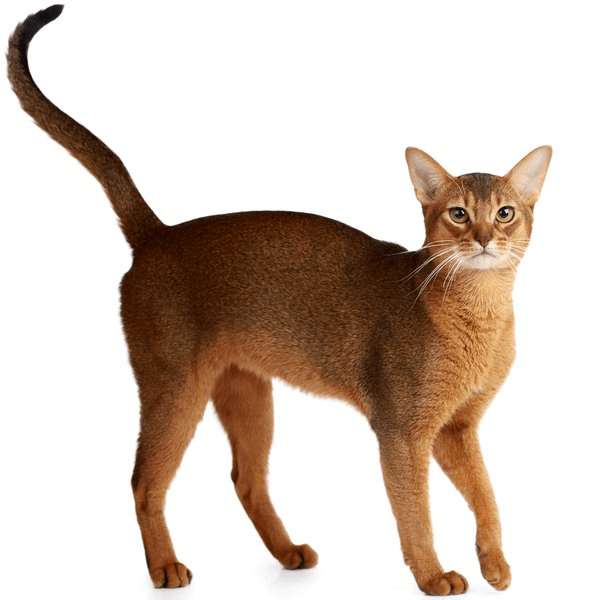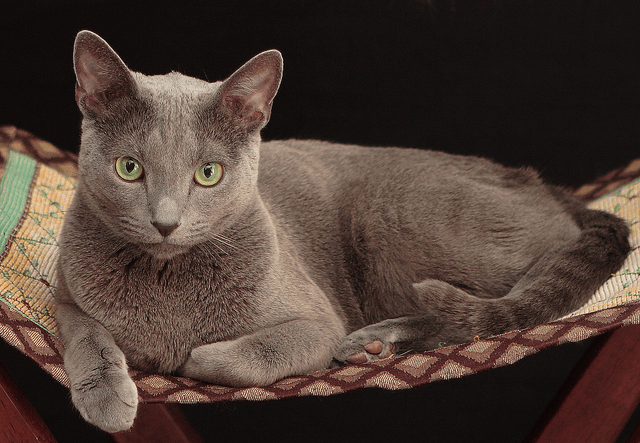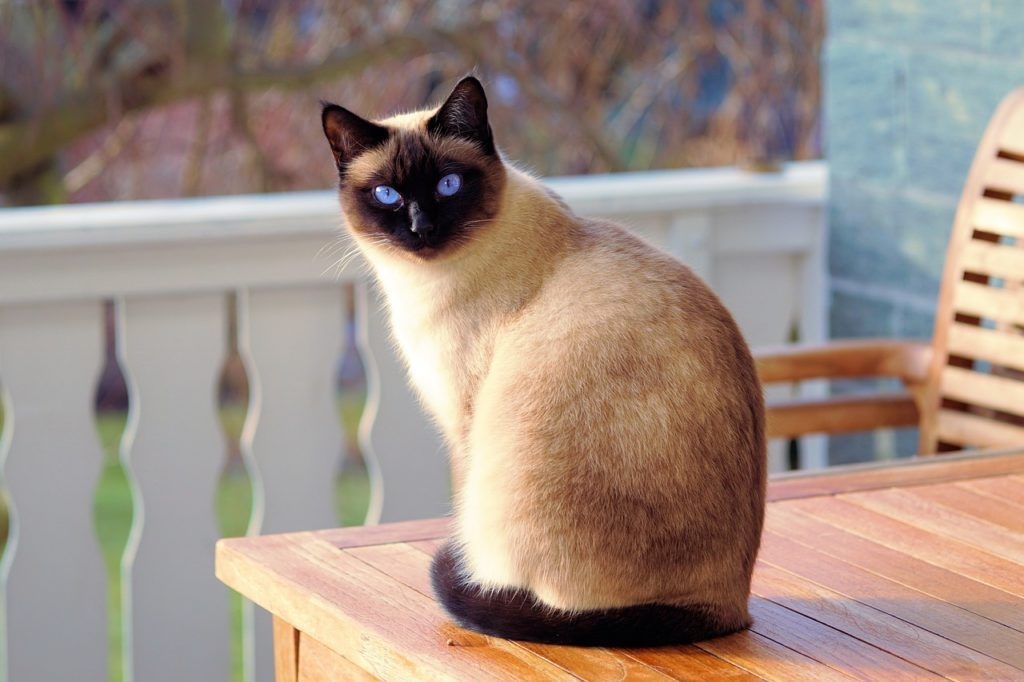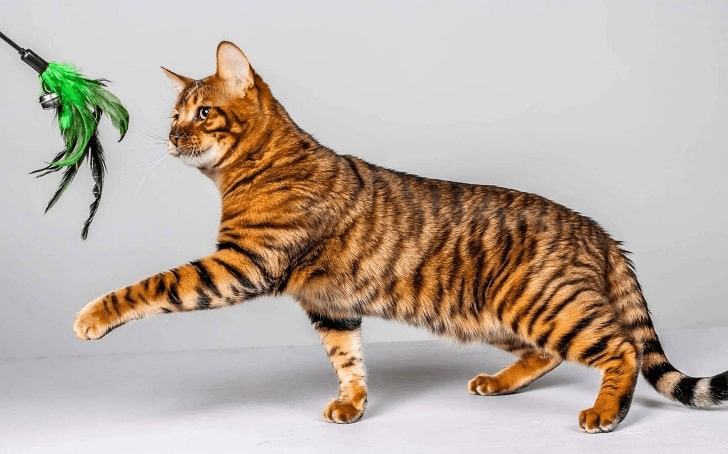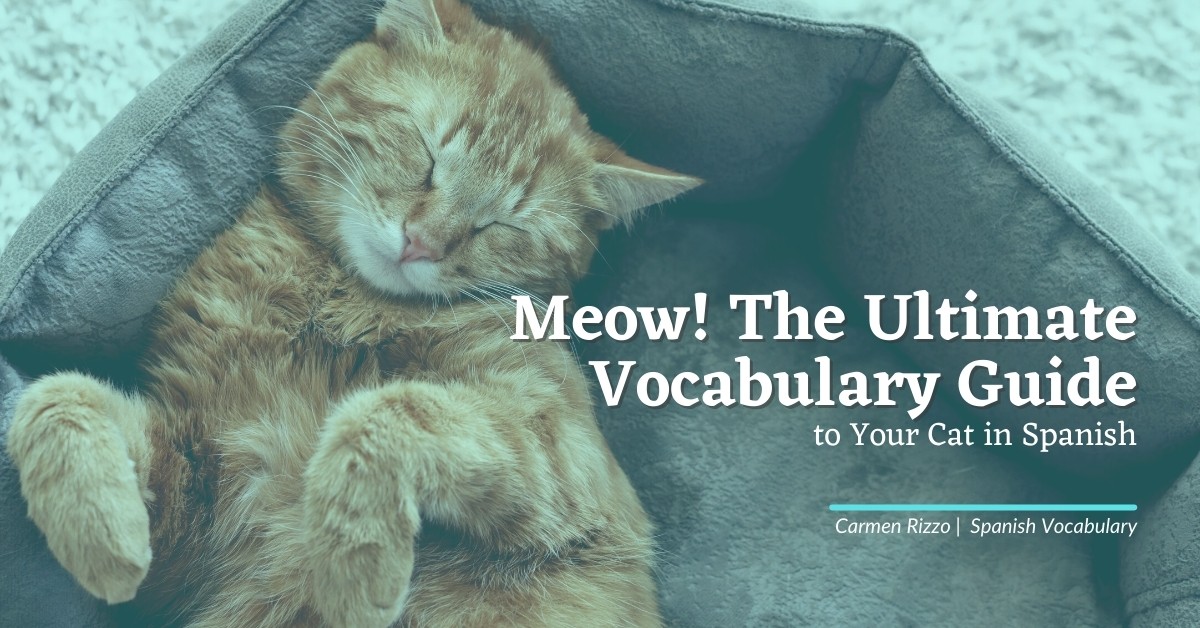
Miau! The Ultimate Vocabulary Guide to Your Cat in Spanish
If you’re a cat lover who’s learning Spanish, you probably want to gush about your cat in Spanish. Honestly, it’s completely understandable considering how cute and amazing cats are!
As cat lovers, the first thing we do when meeting people is ask them:
¿Tienes gato?
Do you have a cat?
or
¿Te gustan los gatos?
Do you like cats?
Cats are the “purrfect” companions. They’re worthy of being praised in any language, all around the world. Keep reading for all you need to know to talk about your cat in Spanish!
A Brief Feline History
There’s a common misconception that cats were domesticated by humans as a way to deal with rats and mice that ate the crops. However, recent studies actually confirm the contrary: humans didn’t domesticate cats, they domesticated themselves.
Just like dogs, cats benefited from living near humans because they had access to shelter and food. In return, they provided pest control for human settlements.
Let’s practice Spanish using these interesting feline facts:
Los gatos se domesticaron solos.
Cats domesticated themselves.
¡La relación entre gatos y humanos es antigua!
The relationship between cats and humans is ancient!
Los gatos empezaron a vivir con los humanos porque era más fácil para ellos alimentarse y abrigarse.
Cats began to live with humans because it was easier for them to feed and have shelter.
So now, you know how cats became a preferred companion animal for humans. But, what makes cats so amazing and interesting? Let’s talk about it in the next section!
Basic Information About Cats in Spanish
Now that you’ve learned a bit of feline history, it is time to discuss what cats are.
Their name comes from the latin “catus,” which evolved to “cat” in English and gato in Spanish. The scientific name for cats is “felis silvestris catus,” but they’re more commonly known as gatos domesticos (domestic or house cats) and gatos ferales o salvajes (feral or farm cats).
Cats are the only domesticated carnivorous mammals from the felidae family. There are at least 60 cat breeds recognized by cat registries.
El gato y la gata refer to the male and female cat in Spanish, but you may encounter some Spanish slang words when people talk about cats, such as michi, mishi, mishito, and michu. Those are unofficial ways of saying “cat” in Spanish.
La Anatomía Del Gato – Cat Anatomy
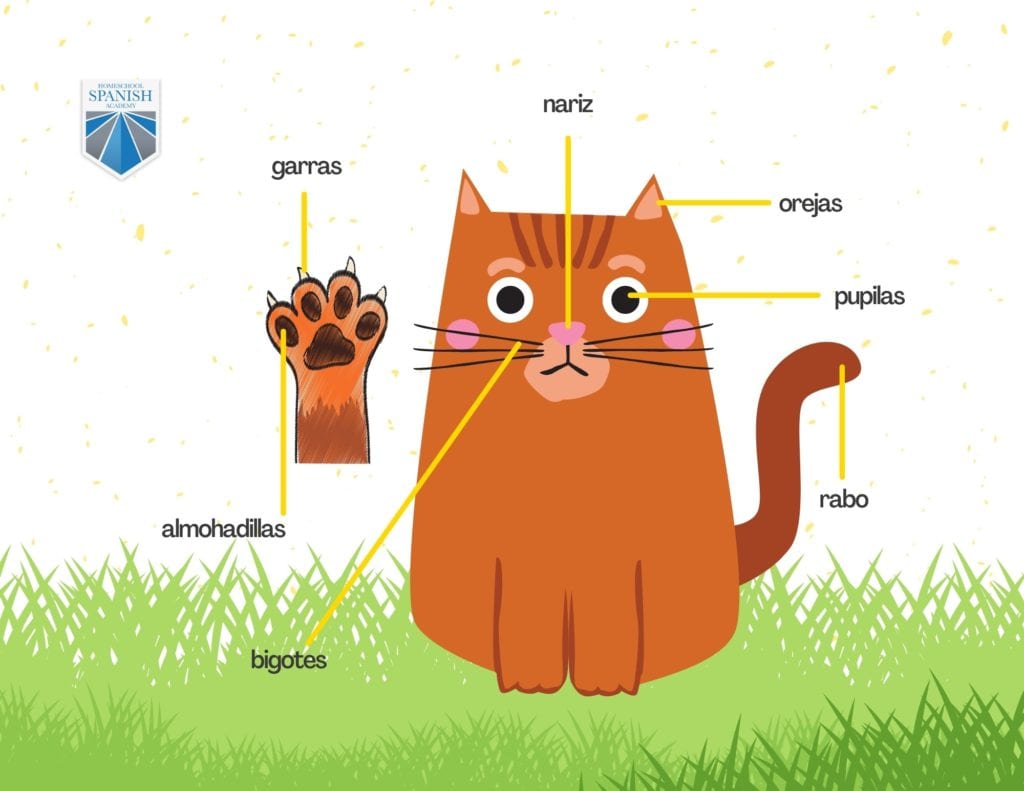
La anatomía del gato (cat anatomy) is similar to the anatomy of bigger felines, like tigers and lions. Let’s take a look at the names of cat body parts in Spanish:
| Spanish | English |
| La cabeza | Head |
| Los ojos | Eyes |
| La pupila | Pupil |
| La nariz | Nose |
| La boca / El hocico | Mouth/ snout |
| Los colmillos | Fangs |
| Las muelas | Grinders |
| La lengua | Tongue |
| Las orejas | Ears |
| Los bigotes | Whiskers |
| El tórax | Thorax |
| Las patas | Legs |
| Las garras | Claws |
| Las garras retractiles | Retractable claws |
| Las almohadillas | Paws |
| La cola | Tail |
| El pelaje | Fur |
| Los huesos | Bones |
| La “bolsa del vientre” | “Belly pouch” |
El Ciclo de Vida Gatuno – Cat Life Cycle
A cat begins its life as a gatito (kitten) in camadas (litters) of four to six kittens. The litter of kittens, or camada de gatitos in Spanish, depends a lot on their mom because kittens are blind for about 10 days after they are born.
After the third month, kitties can be adopted by other families because they already behave like adult cats, know how to survive, and groom themselves. After a year of life, the cat is considered an adult.
La esperanza de vida de un gato (a cat’s lifespan) depends on several elements including where they live, how many other cats are in the litter, and if they are sterilized or not.
Los gatos castrados (sterilized cats) often live more than 12 years if they stay at home most of the time. When cats are not sterilized and spend a lot of time outside, their lifespan decreases to 4-5 years.
Razas de Gatos – Cat Breeds
Now that you know all the important parts of your cat, it’s time to learn about cat breeds. At least 60 cat breeds are recognized, and this blog post presents a handful of the most common ones. To learn more about this topic, check out this cat breeds site.
1. El Gato Abisinio
El gato abisinio (Abyssinian cat) is a popular cat breed because of its physical appearance and personality. This elegant cat’s origin is Egypt, but its name comes from Abyssinia (present-day Ethiopia) because the first cat of this breed which was exhibited in England came from there.
2. El Gato Azul Ruso
El azul ruso (Russian blue) originated in Russia and was developed in England and Scandinavia after World War II. This cat is easily identifiable by its shimmering silver fur. This breed is curious, quiet, friendly, intelligent, and even sensitive to human emotions.
3. El Gato Mau Árabe
The Arabian mau came from the Arab desert. El mau árabe adapted to live in the extreme weather conditions of the Arabian Peninsula. It has short hair and a large and firm body structure.
This cat breed has a loving temperament and displays devotion and affection for its owner. The Arabian mau is a communicative cat that loves to meow.
4. El Gato Siamés Tradicional
Also known as a Thai cat, the traditional Siamese, or Siames tradicional in Spanish, is a social and vocal cat. The most important characteristics of the traditional Siamese cat are its blue eyes, dark extremities, and pale body color. The name of this breed comes from their place of origin, Siam, in present-day Thailand.
5. El Gato Toyger
This cat is a combination of the Bengal and short-haired cats. Toyger breeding occurred in the late 1980s in the United States. The Toyger looks like a miniature tiger. They’re outgoing, friendly, and enjoy being with people. They get along with other pets and are highly intelligent.
Want to learn some other cat breed names? Here is a brief list of more breeds for talking about cats in Spanish:
| Spanish | English |
| El gato americano de pelo duro | American wirehair cat |
| El gato balinés | Balinese-Javanese cat |
| El gato bobtail japonés de pelo largo | Japanese bobtail |
| El gato bombay | Bombay cat |
| El gato bosque de siberia | Siberian cat |
| El gato fold escosés | Scottish fold cat |
| El gato korat | Korat cat |
| El gato manx | Manx cat |
| El gato mau egipcio | Egiptian mau cat |
| El gato munchkin | Munchkin cat |
| El gato persa de pelo largo | Persian cat |
| El gato ragdoll | Ragdoll cat |
| El gato savannah | Savannah cat |
| El gato somalí | Somali cat |
| El gato tonkinese | Tonkinese cat |
| El gato van turco | Turkis van cat |
Each cat is unique in its own way. Their fur texture and color changes, and their eyes are diverse. But what all domestic cats have in common is the way they communicate with human beings.
Cat Communication in Spanish
Of course, cats don’t speak or communicate in Spanish. This section is about the names of the sounds cats make to communicate with humans and what those sounds are called in Spanish.
Cat Sounds
El maullido (Meow) is the most basic sound a cat makes. It’s so easy to recognize as a cat sound that some ancient civilizations named the cat after this sound.
Adult cats meow to communicate with human beings. Cats meow to ask for food, for a door to be opened for them, or just to say hello.
Kittens use el maullido de socorro (Distress Mew) to get the attention of their mom in dangerous situations. This high-pitched meow varies in length, volume, and intensity.
El bufido (Hiss) is the sound cats make when defending themselves to threaten their opponent. To do this, the cat opens its mouth and expels air abruptly. Sometimes they also spit while doing this.
If los gruñidos (Growls) are long, they’re called growls in English, and if they’re short, they’re called snarls. The cat uses These sounds to intimidate their opponent and show they are about to attack.
El ronroneo (Purring) is a rhythmic sound that cats produce without opening their mouths. Cat experts theorize that cats purr as a way to relax themselves, show that they are comfortable, and accelerate healing when they’re sick.
El trino / el chirrido (Trill) – Kittens make this cute sound to communicate with their mother. Cats also use it to greet each other or their human friends.
El cacaréo (Chatter) is an unforgettable sound. Cats make it when they’re in a playful and excited mood—or when they are stalking prey that they can’t reach.
Example Sentences
Escuché a mi gato trinar cuando mi mamá regresó del mercado.
I heard my cat trill when my mom came back from the market.
Rocío no pudo dormir anoche porque dos gatos estaban gruñendo cerca de su ventana.
Rocio couldn’t sleep last night because two cats were growling near her window.
Fernando escuchó un maullido de socorro al ir en bicicleta, resulta que era un gatito perdido en el campo cerca de la carretera.
Fernando heard a distress meow when cycling; it turned out to be a lost kitten in the field beside the road.
Cuando mi gato ronronea me hace sentir feliz porque me tiene confianza.
When my cat purrs, it makes me feel happy because he trusts me.
La primera vez que mi gato cacareo fue porque vio un pájaro por la ventana. Nunca olvidaré lo divertido que fue el sonido.
The first time my cat chattered was because he saw a bird through the window. I will never forget how funny the sound was.
Comportamiento Gatuno – Cat Behavior
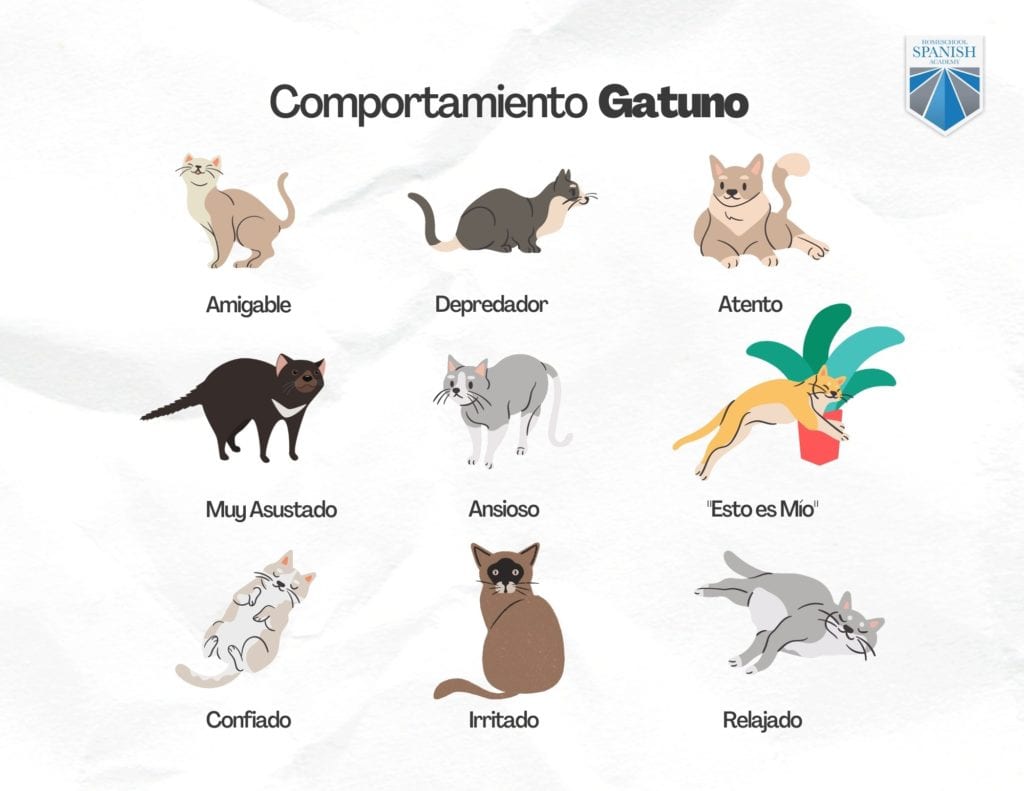
Besides their sounds, body language and behavior are other elements cats use to communicate with humans and other cats. Here are some sentences in Spanish to learn about this while practicing your fluency!
Las colas y las orejas de los gatos muestran su estado de ánimo.
Cats’ tails and ears show their mood.
Los gatos juegan entre ellos y eso puede llevar a peleas.
Cats play with each other and that can lead to fights.
Los gatos duermen durante todo el día y son más activos en la noche porque son nocturnos.
Cats sleep all day and are more active during the night because they are nocturnal.
Mi gato baña a mi otro gatito porque se caen bien. A eso se le llama aseo social.
My cat bathes my other kitten because they like each other. That’s called social grooming.
Aunque los gatos odian el agua, son de los animales más limpios porque se asean constantemente.
Although cats hate water, they are one of the most clean animals, because they groom themselves constantly.
Cuando los gatos están relajados y contentos, hacen un movimiento como que amasan pan. Es muy tierno.
When cats are relaxed and content, they make a movement like they are kneading bread. It is really sweet.
Personalidades Gatunas – Cat Personalities
As a cat lover, you know that each cat has a personalidad (personality). Use these adjectives to talk about your cat’s personality in Spanish.
| Spanish | English |
| Mi gato/gata es… | My cat is… |
| Dormilón / Dormilona | Sleepy |
| Enojón / Enojona | Angry |
| Cariñoso/a | Affectionate |
| Gordo/a | Fat |
| Fiel | Trusty |
| Perezoso/a | Lazy |
| Amigable | Friendly |
| Tonto/a | Silly |
| Asustadizo/a | Skittish |
| Viejo/a | Old |
| Joven | Young |
| Inteligente | Intelligent |
| Astuto/a | Cunning |
| Negro/a | Black |
| Blanco/a | White |
| Moteado/a | Spotted |
Example Sentences
Yo tengo un gato negro.
I have a black cat.
El gato de mi hermana es muy viejo. Apenas puede saltar de la cama.
My sister’s cat is really old. He can barely jump from the bed.
Encontramos un gatito asustadizo cerca del río.
We found a skittish kitten near the river.
El gato de Pamela es muy gordo.
Pamela’s cat is really fat.
Todos los gatos son dormilones.
All cats sleep a lot.
Mi gata es muy astuta. Maulló tanto que me levanté y cuando regresé al sillón, ella estaba echada en mi lugar.
My cat is very cunning. She meowed so much that I got up, and when I returned to the couch, she was lying in my place.
Besides sleeping, grooming themselves and eating, what else do cats enjoy?
Juguetes, Accesorios y Comida para Gato
Cats are hunters by nature, which means that the games they play are usually driven by their hunting nature. But there are a lot of other products that cat’s enjoy when entertaining themselves.
| Spanish | English |
| Los juguetes para gato | Cat toys |
| Los ratones de plástico | Plastic mice |
| Los ovillos de lana | Balls of yarn |
| Las cañas de pescar | Fishing rod |
| Los cascabeles | Jingle bell |
| Los peluches/ Muñecos de felpa | Plush dolls |
| Los rascadores | Scratchers |
| Las torres rascadoras | Scratch towers |
| Los láser de juguete | Toy lasers |
| Las bolsas de plástico | Plastic bags |
| Los calcetines o las calcetas | Socks |
| Las cajas de cartón | Cardboard boxes |
| Las bandas para el cabello | Hair bands |
| Las pelotas | Balls |
| La hierba de gato | Catnip |
| Las manos | Hands |
| Los pies | Feet |
You may have noticed there are some curious things listed in the vocabulary above, but, the truth is, cats play with almost everything.
When shopping for your cat, remember to get them some comida mojada (wet food), una caja de arena (litter box), and some croquetas de gato (cat food).

Download FREE Cats in Spanish Crossword Puzzle!
Type your name and email below to get a free crossword puzzle about cats in Spanish to practice your new vocabulary!
Cat Names in Spanish
Give your pets cute names that are easy to remember and say. Popular pet names for pets vary from region to region and from one language to another. Here’s a brief list of ideas to name your cats in Spanish:
| Michi | Misifús |
| Michito | Pelusa |
| Peludo | Tigre |
| Tigresa | Simba |
| Nala | Aslan |
| Mia | Isis |
| Kitty | Silvestre |
| Nene | Matute |
| Zeus | Magnus |
| Cassata | Mauricio |
| Tito | Timón |
| Suertudo | Rayas |
| Luna | Noche |
| Motas | Manchas |
Don’t Let the Cat Get Your Tongue!
Improve your communication skills by talking about your cat in Spanish today with a certified, native-speaking instructor. Here at Homeschool Spanish Academy, we have more than 10 years of experience teaching Spanish and offer flexible scheduling, tailored Spanish packages, and even high school Spanish credits. And most importantly, all the tools you need so that the next time you practice your Spanish el gato no te coma la lengua. Try it out for yourself in a free trial class!

Ready to learn more Spanish vocabulary? Check these out!
- ‘How Much Is It?’ in Spanish: A Guide to Travel and Shopping
- Familial Bonds: Expressing ‘Sister-in-Law’ in Spanish and Family Vocabulary
- 100 Easy Spanish Words for True Beginners
- Earth Day Projects for Kids + Spanish Earth Day Vocabulary
- How to Talk About the Temperature in Spanish: Fahrenheit, Celcius, and Descriptions
- Car Parts Spanish Vocabulary List: Learn Using Pictures
- Top 15 New Year’s Resolutions in Spanish
- Talk About Hurricanes And The Weather in Spanish
- An Easy Vocabulary Guide to Describe the Post Office in Spanish - February 10, 2023
- Guatemala’s Biggest, Most Colorful Market: Chichicastenango - December 28, 2022
- 8 Sad Spanish Songs for When Your Heart Is Broken - December 6, 2022

